October 5 - 11, 2014: Issue 183
Nada Herman
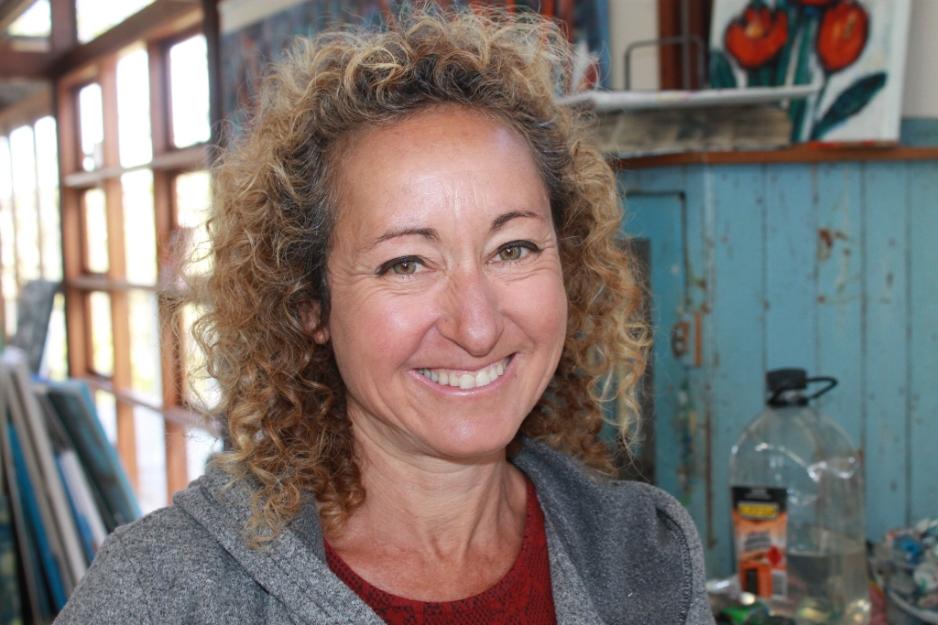
Nada Herman
Our October Artists of the Month is a remarkable lady with a huge talent for creating paintings that infuse their viewers with joy. Bright colours, familiar headlands and waterways are brought into sharp relief and seem to smear their essence across your soul so that even the air in these visions may be tasted.
Nada won her first prize in the art world in her 10th year. Educated at Avalon Public School and the then relatively new Barrenjoey High School, Nada went on to study visual arts at Seaforth TAFE and received a Bachelor of Visual Arts from the Alexander Mackie College of Advanced Education, UNSW in 1990. Her earliest teachers were multiple Wynne Prize awarded winner, and her grandfather Sali Herman, and father Ted.
Nada first exhibited her work publicly in 1992 in an exhibition called Three Generations at the Warehouse Gallery, Narrabeen, alongside works by grandfather Sali and father Ted. While her grandfather's works focussed on urban scenes after serving during WWII, her father's works beautiful renditions of Pittwater and other landscapes, Nada has become renowned for her own individual colourations of flowers and seascapes.
A mother of three girls, with a newly opened Palm Beach gallery, an exhibition at the Four Seasons, and one of those participating in January 2015's ArtSpot Exhibition, Nada is a hard working successful painter with decades of experience in turning visions into the tangibly visual.
Where and when were you born?
1965, at Mona Vale Hospital, my family has been in Avalon since the 1950’s. My father bought here when there was very little in the way of houses – they were selling off lots of land as holiday places. There were kangaroos and wild horses and lots of kolas everywhere. I haven’t seen a kola here for a long time unfortunately.
Where did you go to school?
Avalon Public school and then Barrenjoey High School.
When did you first notice that you like creating?
I was very very young. I think I felt creative before I could walk, from the moment I could hold a crayon in my hands. I think it’s a burning desire for most people who do create.
Can you remember any of your first creations?
No. I was always drawing, my father being an artist, and my grandfather being an artist, I would be sitting in the studio watching and observing. I would be drawing with my crayons to begin with.
I started painting in oils when I was nine, maybe eight, and won my first art prize with a painting of my father back then in the local schools competition.
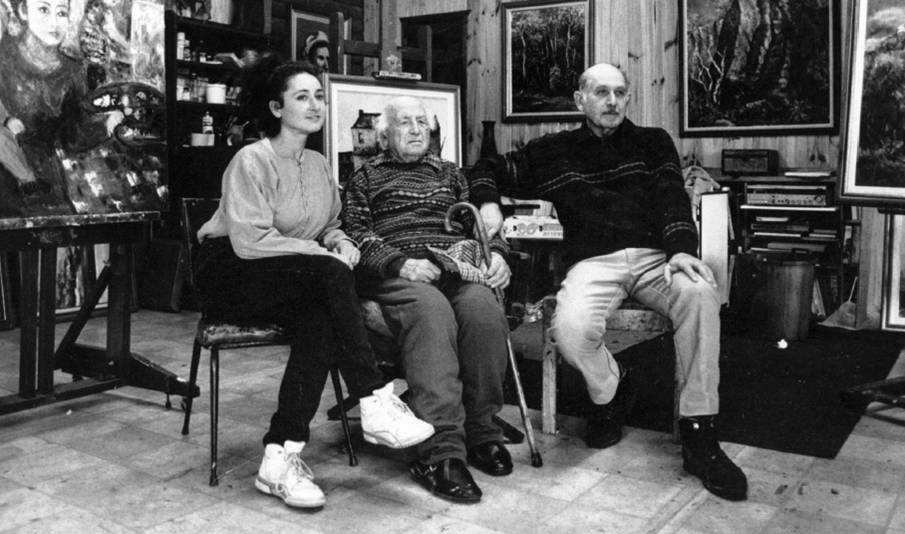
L - R Nada Herman, Sali Herman and Ted Herman. Photograph by Geoff Henderson, 27 August 1992.
So you were comfortable doing this even at that age?
Well, that weren’t many oil paintings being handed in by people my age. Oil paints were readily available to me - I often think that might be why I paint with such intensity because it was available to me, I didn’t have to count every cent that I was spending as I put it on the canvas as a lot of artists have to do in order t survive – they have to budget every work with how much paint they can use. I had so much paint available to me all the time, it was there in front of me.
So that kind of abundance helped create abundance within your art works?
In some ways I think it might have.
When we spoke earlier you remarked that you try to invest all your artworks with happiness – is that the stage of development you’re at now, one of happiness; your works make you feel happy and that’s what you want them to communicate?
That’s right. I think that is the vibe on the Northern Beaches, this wonderful lifestyle that we have, that’s why we’re here, to be happy.
In developing your art, if you’re at the point f happiness now, where did you begin from?
I don’t think I have a conscious awareness of changes within myself that apply to the development of my style. I think I can look back at my early pieces and in some ways I almost wish I could go back in time and paint like that again because it was so fresh and naïve and alive. I’ve always had the same energy within the works but it has got more and more intense and more confident and maybe there’s a sense of maturity in my work now. But you can’t predict how you’re going to progress or even see it yourself unless you look back five years or longer and compare your works – it’s a gradual process.
I think all of mine are degrees of joy, and that’s not done intentionally either, it’s just part of my nature and living in this area; I’m not in a war zone or place of conflict. Had I lived in the inner city it may be different.
You also enjoy being outdoors though – you run each morning?
Yes, I run along the beach and love being outdoors. I like the bush we’re surrounded by here, the serenity – I don’t like travelling too far, even in to the city. I love the mountains as well.
Influences on your work, apart from your father and grandfather, were there other artists whose work appealed to you while you were developing your own works?
I’ve always loved the French Impressionists. In high school I did an assignment on them, for French as well as for Art. I used to copy their paintings for the project and I would cite them as my biggest influence, particularly Van Gogh.
I’ve been to Europe and Holland and seen his exhibitions and he still blows me away. I think that’s who I’m most connected to – Van Gogh, and Matisse.
There are a few recent developments for you too – you’ve just opened a gallery at Palm Beach?
Yes, this just became available so I took the opportunity and ran with it. everything can be a risk but I’m diving in and going for it. it’s a perfect time of year to be opening this, coming into the Summer season.
At this stage the Nada Herman Gallery will be open everyday from 10 until 4 pm. It's opposite the Palm Beach Wharf at 1112 Barrenjoey Road. There are other artists who will be displaying works and manning the gallery; that was initially my biggest obstacle; how I was going to man it.
This month we also have the second Open Weekend for the Pittwater Artists Trail (October 18-19), and you’re also part of that. what can visitors to Hy Brasil and your studio here expect to experience?
I hope this will be as we usually do; everyone comes up and makes themselves at home, they wander around the house and gardens and enjoy the ambience of the property – they can bring a picnic – they can drive up the driveway, there’s loads of room to park here – most usually wander around and see the paintings and where I live and where they are created; my studio.
We usually have some crayons here for children to draw with while mum and dad wander around – sometimes we have music playing here as well, but normally during the May Open weekend, for Mother’s Day.
You are also going to be part of January’s ArtSpot Exhibition?
I am. I’m also at the Four seasons Hotel at present – this is a permanent show of mine. It’s on the second floor; as you enter you’ll be confronted by a big painting by me – there’s about ten pieces in there.
These are a bit of everything; beach, harbour, flowers and some Pittwater views. I’ll be changing the paintings every few months – this is a great spot as you have visitors from all walks going through and seeing a great introduction to Australian art; my work typifies the Australian lifestyle, its beaches and waterways.
You’re clearly a working artist and a hardworking artists at that – what would you say to our younger readers who wish to embark on this career as full time work?
Just have some determination. I think it’s the same as any chosen career path or anything in life you want to do; you can succeed, it’s just how much you put into it. I’ve always been a very strong willed person and I don’t let go until I’ve achieved what I want to achieve. Sometimes it is a battle but you do get there.
Occasionally you get knock backs but keep going. I would say don’t get down if people aren’t accepting of your work the way you may expect them to; you have got to have faith in your ability.
I’d point to Van Gogh, my role model; he wasn’t accepted. To go through a life of not being accepted for your art and then to die and then be accepted, there would be nothing worse, but he had faith in his work. Unfortunately everybody can’t love the same style of painting, so there will be people out there that reject you; don’t take it personally, just keep going.
It’s like music or acting, or anything in the art world, there will always be critics, and they are what can make you try harder.
What are you painting at present, what is your subject focus?
I’ve been doing a lot of floral scenes with landscaping in the backdrop; so Pittwater and Lion Island or the ocean and then the florals in the foreground. In the old days I used to do a lot of beach scenes with people on towels and the umbrellas – I’ve always had a main foreground, and now it’s becoming floral. An example of this is that I’m doing red hot pokers which in the last six months have been popular with people who buy my art – that intense red colour of the poker against the blue water.
Why red hot pokers – what attracted you to them?
It’s very subconscious again I think; as artists we’re observing everywhere we go and then all of a sudden you will be painting and go, ‘I remember that’ – but you weren’t consciously thinking about it – I think I’m always drawing for contrast of colour on the canvas – when you have got such a blue with the water, you need red – so where do you get red from; I’d be looking around and go ‘oh, red hot pokers’ – you’ve got to pick a flower that grows beside the ocean, it can’t be a rose or something like a tulip because you wouldn’t see them beside the ocean – but red hot pokers are a very durable flower and seem to thrive in that environment, they can cope with that wind and salt air.
If you could be another creature for a day, furred, feathered, finned or scaled – what would you be and what would you do?
A dolphin is the most appealing to everybody I think because they’re so free. I also like a horse because I like running on the sand too. I’ve always loved horses but I’d want to have a good owner. But no, a dolphin – for swimming and I’d just want to communicate with the humans.
What is your favourite place in Pittwater and why?
That’s easy; my temple – up the top of the sand dunes in Palm Beach. I love it there because you can see the Pittwater on one side, if it has been raining you have a waterfall coming down behind you, making it tropical; you look up at the beautiful lighthouse and you have the ocean on the other side. What more could you ask for – it’s so pretty. It’s the most north point of here – I often go up there and meditate.
What is your motto for life or a favourite phrase you try to live by?
My grandfather would said something that stuck with me; ‘if you look up into the stars at night time, some are brighter and some are duller, and some flicker, and some don’t. you can be the one that stands out the most if you want to in life by being the brightest star through what you make of your life, or you can be the ones that are subdued in the background – it’s up to you.’
I always used to reflect on that and saw in this that whole process of you can achieve what you want, it’s your life, you have got to go for it.
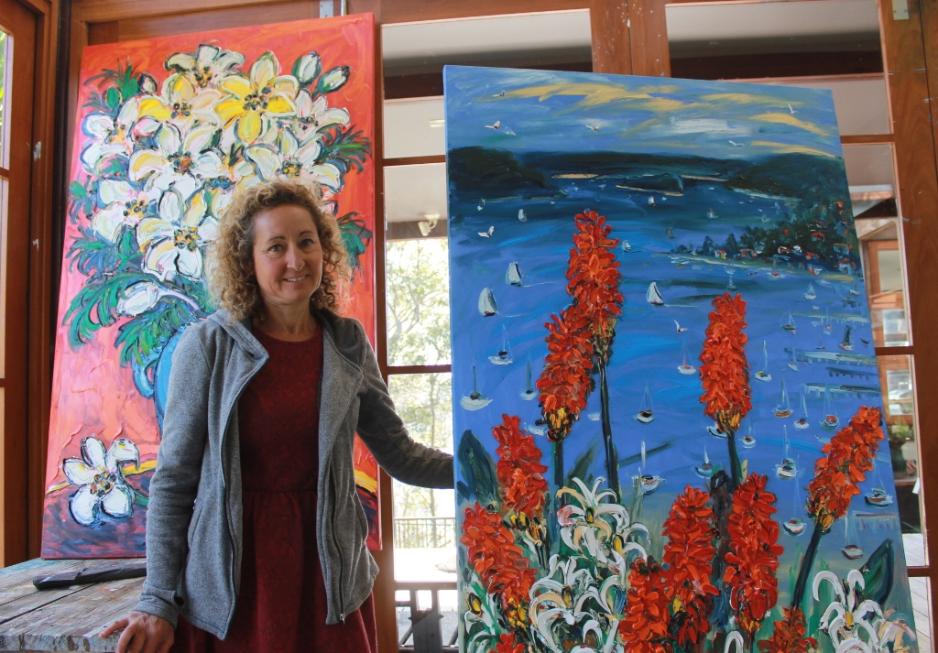
Nada with recent work - red hot pokers.
Extras:
The Hermans - Art In The Family Exhibition at Manly Art Gallery - Curated by Katherine Roberts - February to March 2010
Lieutenant Sali Herman
Interview with James Gleeson - Novermber 1978 HERE
Sali Herman was born in Switzerland in 1898. During the 1930s many artists like Herman came to Australia to escape the Fascist dictatorships of Europe, bringing new ideas about art and culture with them. He arrived in Melbourne in 1937 and studied briefly at the George Bell School, advocates of mild experimentation along the lines of early European modernists such as Cezanne. While living in Paris Herman had seen the work of many significant modern artists, including Van Gogh, Manet and Courbet.
Herman enlisted in the Army in 1941 and was assigned to the First Camouflage Section. He later became a sergeant with the 3rd Royal Australian Engineers Training Battalion at Kapooka. He was appointed an official war artist in 1945 and worked in the Pacific for five months, recording scenes in Lae, Torokina, Bougainville and Rabaul. During this time he did many field sketches, which formed the basis of the 26 paintings he submitted to the Memorial.
Herman is best known for his paintings of inner-city streets and slums around Sydney, which he did before and after the war. He was a keen observer of his surroundings and was able to translate the essence of a scene into paint using geometric blocks of form, pattern and contrasts for dramatic effect.
After the war Herman had a successful career as a painter, exhibited widely and won several major prizes. He received the Wynne Prize three times and the Sulman Prize twice, first in 1946 with Natives carrying wounded soldiers, a painting he produced as an official war artist, and also in 1948 for The Drovers. He won the Wynne Prize four times; in 1944 for McElhone Stairs; in 1962 for The Devil's Bridge, Rottnest; again in 1965 for The Red House; and in 1967 for Ravenswood I.
SALI HERMAN - LECTURER FOR ART EXHIBIT
Sydney artist, Mr. Sali Herman, whose work is well known throughout the Commonwealth, has been appointed lecturer for the Jubilee Art Exhibition in Lismore from March 6 to March 20. The exhibition, which will be held in the Civic Chambers, is being sponsored by the National Art Gallery, of N.S.W. Mr. Herman has been one of the most successful lecturers working on travelling 'art exhibitions. He has been specially selected by the Art Gallery for the series of' exhibitions planned in celebration ofthe Australian Commonwealth Jubilee. Mr. Herman was born in Zurich, Switzerland, 53 years ago and went to Paris to study at the age of 16.
He has travelled extensively throughout Europe and has a firsthand knowledge of painting in all its phases. Mr Herman came to Australia in 1936. He was a foundation member of the Contemporary Art Society and an official war artist with the A.I.F. in 1945-46. He has made a habit of winning major art prizes, among them being the Wynne Prize in 1944, the Sulman Prizes in 1946 and 1948,and the Geelong and Bendigo Prizes In the same year. Mr. Herman's work is exhibited in national and other art galleries throughout Australia and in the Australian legations in New York and Washington. SALI HERMAN LECTURER FOR ART EXHIBIT. (1951, February 28). Northern Star(Lismore, NSW : 1876 - 1954), p. 4. Retrieved from http://nla.gov.au/nla.news-article96554336
Ted Herman moved to Australia with his father and sister Ingeborg in 1937. He served with the Royal Australian Air Force as a ground engineer during World War II in New Guinea, Burma and Japan, and was an apt linguist. Post- war Ted developed war-time sketches into paintings. His first solo exhibition was at the Terry Clune Gallery, Potts Point in 1958, and while one of his landscape paintings was hung in the Wynne Prize of that same year.
Work as a flight engineer for Qantas curtailed his painting until he retired in 1978 when his works were exhibited widely in solo and group exhibitions around Australia, including the Mosman, Warringah and Sutherland art prizes. Ted painted portraits, oil and watercolours of the city, bush and waterways, the subjects that most appealed to him. He was an member of the Peninsula Art Society over its 21 years of operation, exhibiting regularly at the Manly Art Gallery & Museum.
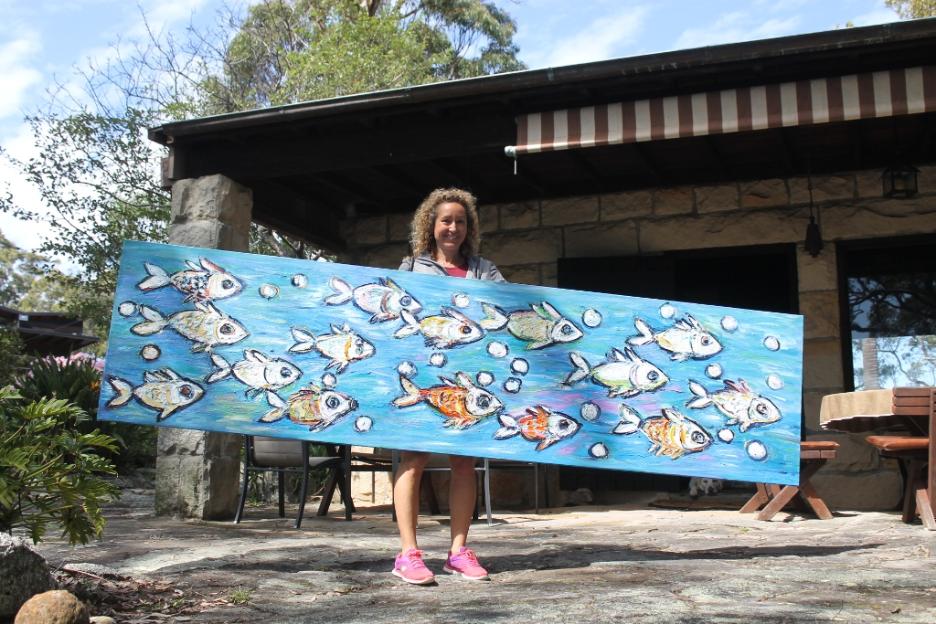
Nada at Hy Brasil - September, 2014.
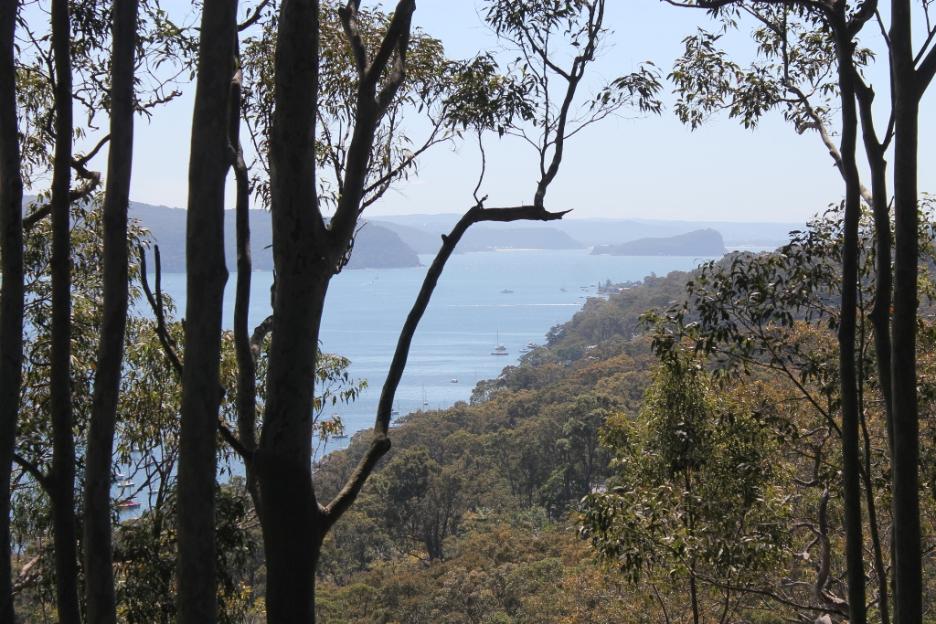
The view from Hy Brasil - where Nada's studio is.
Copyright Nada Herman, 2014.